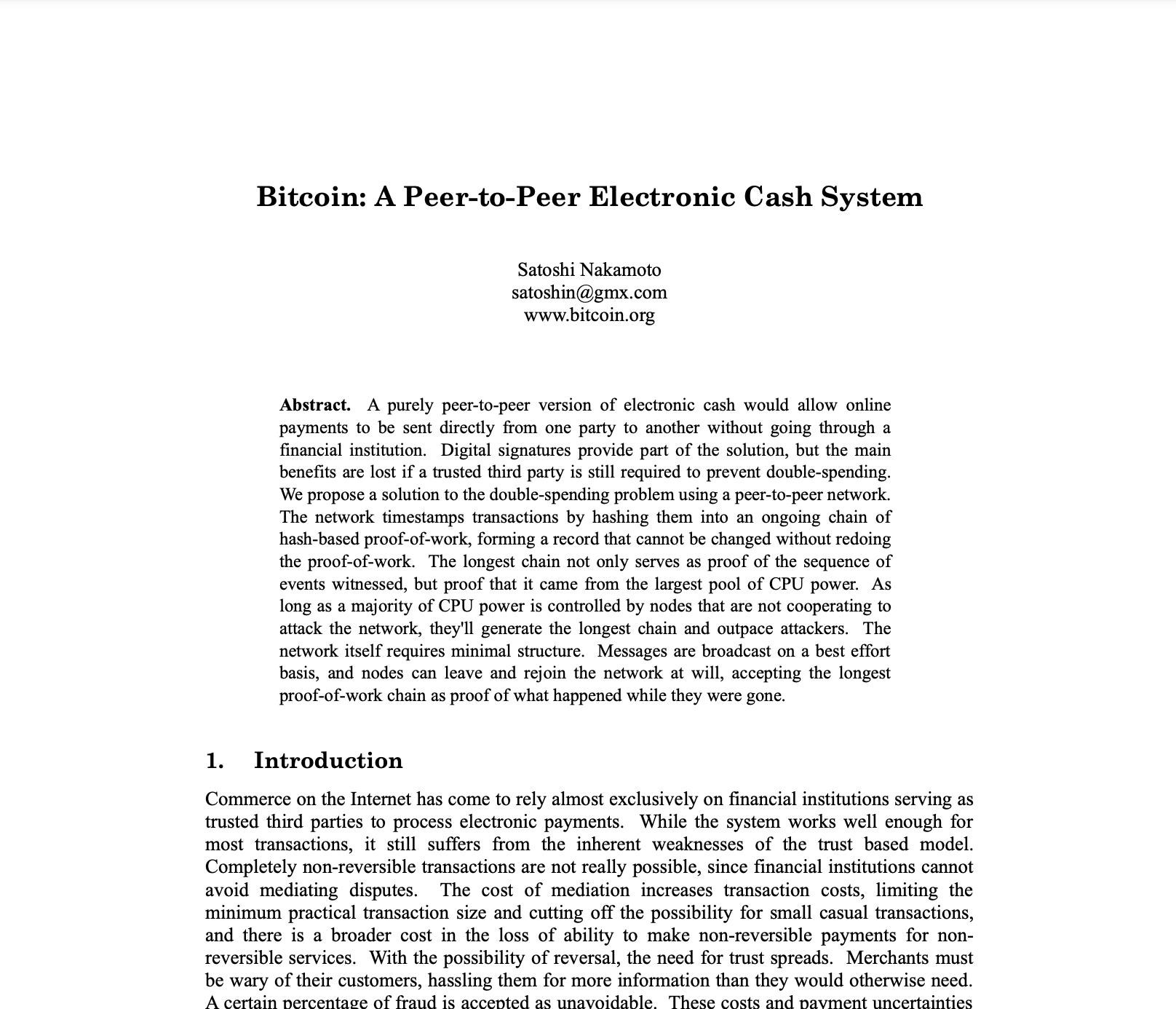Every year on October 31, children dressed in pumpkin masks and eccentric costumes may ask you for candy, and the cheerful bonfire parties are also hard to forget. That said, October 31 is not just a day for celebration in the real world, as it holds great significance for the crypto world as well.
October 31, 2023, marks the 15th anniversary of the release of the Bitcoin whitepaper. Fifteen years ago on this day, an anonymous geek with the pseudonym Satoshi Nakamoto published a paper titled Bitcoin: A Peer-to-Peer Electronic Cash System on the P2P Foundation website. This marked the debut of the concept of Bitcoin, which sparked a financial revolution that later gave rise to DeFi applications, smart contracts, and token issuance.
Why October 31?
Satoshi Nakamoto’s true identity remains unconfirmed to this day, and in 2010, he disappeared from the scene after his early involvement in Bitcoin’s development. As such, we have no idea what his exact intentions are for choosing to release the whitepaper on October 31. However, there’s an opinion on the internet that this date choice aimed to reinforce the idea that Bitcoin is a decentralized project with no central issuer. Instead, it is generated through the calculations of all the nodes participating in the network, and anyone can join the process. To achieve that, Satoshi needed time, a reasonable period to give everyone an opportunity to engage in BTC production.

Source: https://bitcoin.org/bitcoin.pdf
Two months might have sufficed, but to account for unforeseen circumstances, Satoshi allowed for an additional four days. Therefore, on January 3, 2009, we witnessed the birth of the Bitcoin genesis block. Choosing October 31 for the whitepaper release might have been a strategy to take advantage of the festive Halloween atmosphere, making it difficult for people to notice Bitcoin’s debut. This would allow Satoshi to focus more on preparations for the genesis block.
Key Bitcoin Milestones in the Past 15 Years
On October 31, 2008, the Bitcoin whitepaper was released.
On January 3, 2009, the Bitcoin network went officially live, with Satoshi Nakamoto mining the first Bitcoin block, known as the genesis block. Since then, the network has expanded and attracted a growing number of participants.
On October 5, 2009, New Liberty Standard, the first Bitcoin exchange, was founded and set the baseline price for Bitcoin at $1 = 1,309.03 BTC.
On May 22, 2010, the first Bitcoin transaction occurred: Florida programmer Laszlo Hanyecz bought two pizzas worth $25 with 10,000 BTC.
On November 27, 2010, the world’s first Bitcoin mining pool, Slushpool, was established. With the emergence of exchanges and mining pools, the crypto space started to build a complete industry chain covering both upstream and downstream players.
On February 9, 2011, the BTC price surpassed $1 for the first time.
On September 27, 2012, the Bitcoin Foundation was co-founded by a group of early adopters, developers, and entrepreneurs passionate about Bitcoin and blockchain technology, with the aim of promoting the development and adoption of Bitcoin and blockchain technology.
On November 28, 2012, Bitcoin experienced its first halving, reducing the block reward from 50 BTC to 25 BTC.
On October 29, 2013, Robocoin introduced the world’s first Bitcoin ATM in Vancouver, Canada, allowing users to exchange BTC for Canadian dollars.
On February 28, 2014, Bitcoin witnessed its first dark moment. Mt. Gox, the world’s largest Bitcoin exchange at the time, suffered a massive security breach, resulting in the theft of 750,000 bitcoins in users’ accounts, and the exchange’s own holding, roughly 100,000 BTC, also went missing. The incident served as a wake-up call for the entire crypto industry, teaching users a harsh lesson.
In December 2015, over 100,000 merchants were reported to accept Bitcoin payments.
On July 9, 2016, Bitcoin saw its second halving, reducing the block reward from 25 BTC to 12.5 BTC. During the same year, two new mining pools, ViaBTC and BTC.com, emerged, contributing to stable growth in the crypto mining sector.
On August 1, 2017, internal disputes within the Bitcoin community over block size limits led to a hard fork, creating Bitcoin Cash (BCH).
On November 28, 2017, the BTC price crossed the $10,000 mark for the first time.
On November 15, 2018, BCH experienced another contentious hard fork, resulting in the creation of two competing versions: Bitcoin Cash ABC and Bitcoin Cash SV.
On October 12, 2019, the BTC hashrate exceeded 100 EH/s for the first time.
On May 12, 2020, Bitcoin underwent its third halving, reducing the block reward from 12.5 BTC to 6.25 BTC.
In August 2020, led by Michael Saylor, business software giant MicroStrategy announced that it purchased 21,454 BTC for $250 million, the first BTC investment made by a traditional institution on such a scale.
On June 9, 2021, after a majority vote, El Salvador’s Legislative Assembly passed the Bitcoin Law and adopted Bitcoin as its fiat currency, making it the first country to officially recognize Bitcoin as a legal tender.
On October 19, 2021, BITO, the first Bitcoin futures ETF, was listed on the New York Stock Exchange.
On November 10, 2021, the BTC price exceeded the $68,000 mark.
On December 21, 2022, Core Scientific, which used to be a Bitcoin mining giant, filed for bankruptcy. In 2022, due to the declining BTC price and rising energy costs, several mining companies also faced bankruptcy.
On January 21, 2023, Bitcoin developer Casey Rodarmor launched the Ordinals protocol on the mainnet. The boom of BRC-20 tokens drove up Bitcoin’s trading volume, boosting the profitability of Bitcoin mining.
On June 15, 2023, BlackRock, the world’s largest asset management company, submitted a Bitcoin spot ETF application to the SEC. This year, several institutions, including Valkyrie, Invesco, and WisdomTree, also submitted applications to the SEC for Bitcoin spot ETFs.
Conclusion
Looking back on Bitcoin’s history, it is clear that the coin has scored remarkable achievements and had a profound impact on the entire blockchain industry. Over the past 15 years, Bitcoin has evolved from a target of doubt, criticism, and even slander in the early days into a mainstream store of value around the world. Today, as Bitcoin ventures into an even broader world, regulation remains a key issue. The delayed approval of a Bitcoin spot ETF by the SEC and the cautious regulatory stance from other agencies both stem from the lack of a well-defined crypto regulatory framework, which creates significant risks of market manipulation.
Going forward, Bitcoin and the whole crypto community need to respond to regulatory concerns, find a balance between decentralization and traditional regulatory frameworks, and establish a new order. These efforts are the key to whether Bitcoin could once again record exponential growth.